
To react flexibly to customer requirements for automation projects, it must be possible to accommodate a choice of bus systems, offer rapid planning implementation with transparent costs and functionalities - from the minute the project is tendered. This article describes ways to pre-plan small functional units through control cabinet-free automation concepts, whose core components are to protection category IP67. A particular emphasis is placed on the potential savings offered by pre-assembled components.
The first steps to increasing plant efficiency begin much earlier than many would think - and are not just limited to a few components. From start to finish, an installation concept must be holistic, integrated, open and flexible - from the control system right down to the last screw. Key factors that will be considered here in greater detail are I/O modules and their supplementary products. The question is: where can we find the potential savings that allow plant and machine manufacturers to enter the market on a more competitive basis?
Potential savings in the planning costs
One of the essential factors in creating an efficient plant is the planning of the automation system. Here, the significant savings potential lies in re-using system components that have already been produced. With a proactive approach functional parts are planned right from the start on the basis of the mechanical, software-technological and electrical concepts.
Here, it is preferable to use small I/O islands - the sensor/actuator boxes. These functional units are defined mechanically according to their installation parameters to enable them to be easily connected to other functional units. From a software-technological point of view, these functional units are described - bus-independent - in the relevant automation tool together with all functions and diagnoses. This enables integration into fieldbus systems such as Interbus, Profibus, DeviceNet or CANopen. The Fieldline I/O system from Phoenix Contact provides open and independent support for these bus systems. Fieldline offers universal mapping of the I/O data and diagnosis data, as well as standardised connection technology for the bus sensor, actuator connection and the power supply.
Potential savings on installation time
After the planning and mechanical construction of the installation, the electronics system is installed. This creates further potential for cost savings: flexible unit installation, the use of pre-assembled wires and cables as well as simple parameterising and setting. The Fieldline I/O system can be easily adapted to the installation conditions. The two installation directions provided in the housing enable the I/O system installation to be adapted to the plant concept and not the other way round. Particularly, systems to protection category IP65 and IP67 are often installed under adverse conditions. This means that the control elements must be clearly visible and easy to install - without having to remove parts or take any other steps. Given the variety of I/O points in the field, every manipulation made counts, and these must be possible to perform in harsh environmental conditions (see Figure 1).
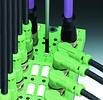
It is only with detailed, pre-planned system parts that parameters such as the cable lengths, connection technology and cable quality requirements are already known. Thus all preconditions are met to enable complete cabling using pre-assembled lines for the bus, power supply and the sensor and actuator cabling. This means there is no need for on-site wiring, which often holds a high potential for errors, particularly with buses. Errors when setting up the shield or a mix-up of the cable strands are seldom recognised straight away but rather only when the installation is running. Assembled cables are cheaper than buying the material to assemble them on site. Furthermore, they are produced under controlled conditions that ensure proper sealing and electrical parameters - and they are electrically tested.
Potential savings on set-up costs
Pre-designed installation parts can be 'put together' and operated as if they came out of a kit. The wealth of experience regarding the individual installation parts as well as existing software components enable quick and easy set-up on site. Functions are tried, tested and described completely, allowing the concentration to be on the customer-specific design of the solution, the operation and visualisation and the testing under full capacity.
Figure 2 shows the sequence of two screw terminals in operation. Here, planning and set-up concentrate on integration; the screw terminals themselves were planned in detail and preset.
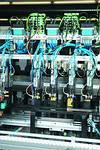
Potential savings on the logistical costs
For bus-specific or proprietary solutions, changing the bus system to suit customer requirements means that the accessory program must be completely re-planned as well. Really effective open-bus planning shows consistency in the power supply concept, in the sensor and actuator connection as well as in the kind of bus connection. Cable lengths must be available as standard products in sensible sizes. This avoids expensive versions and types that require special treatment. The cables' bus-specific parameters must be observed. Furthermore, the variations for the sensor and actuator boxes as well as the accessories must be structured accordingly. This allows spare parts stocking and inventory control to be reduced to a minimum. The aim of installation planning must always be to meet demands using a manageable basic range of modules and utilities (see Figure 3).
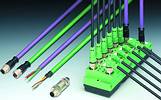
Potential savings on service costs
When re-using functional units, it is worth investing what is a considerable, but one-off, expenditure of time for programming and error handling. Entire installations that are made up of functional units provide varied kinds of diagnosis information depending on the bus system selected. This information can be integrated into higher-level visualisation. However, the on-site displays should certainly not be neglected: eg, clear signalling of the bus status, power supply and I/O level. If a fault occurs, or when faults are initiated (deterioration of the bus communication or undercutting of warning levels with the power supply), defective components must be simple to localise and exchange. In some circumstances, it makes sense to repair a defective cable on site. Thanks to the consistent application of M12 connection technology for Fieldline boxes, defective cables can be exchanged individually - without having to change expensive hybrid cable. Because M12 technology is available worldwide, replacement parts can be obtained quickly - even when a pre-assembled cable has to be replaced by a cable assembled on-site. Easy access to connections as well as simple box installation make maintenance work a controllable scenario (see Figure 4).
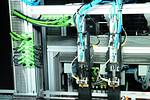
Investment security
Installation concepts must be future-proof. This demand also affects the design of the automation. The mentioned screw mounting system already existed and was originally produced using Interbus SAB. The product changes required the additional integration of two screw terminals, which were integrated into the existing concept using Fieldline. The software was amended for the stations and the system was soon operating again. Particular emphasis should be given to the integration of complex functions normally undertaken using control cabinets. For this, it is important to have a display of the process and diagnosis data that is uniform and valid for all buses. The Inline I/O family (IP20) and Fieldline (IP67) provide a coordinated concept - including the accessory program (see Figure 5).
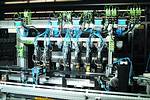
Conclusion
Only a comprehensive approach to planning complex installations will lead to success in reducing the logistics, maintenance and set-up costs, in lessening the installation time and in creating investment security. Flexible additions and extensions to existing installation concepts - including comprehensive communication with the 'world of IP20' - are the most decisive factors for the variable and cost-effective implementation of market requirements.
For more information contact Duncan Venter, Phoenix Contact, 011 793 7121, [email protected], www.phoenixcontact.co.za
| Tel: | +27 11 801 8200 |
| Email: | [email protected] |
| www: | www.phoenixcontact.co.za |
| Articles: | More information and articles about Phoenix Contact |
© Technews Publishing (Pty) Ltd | All Rights Reserved